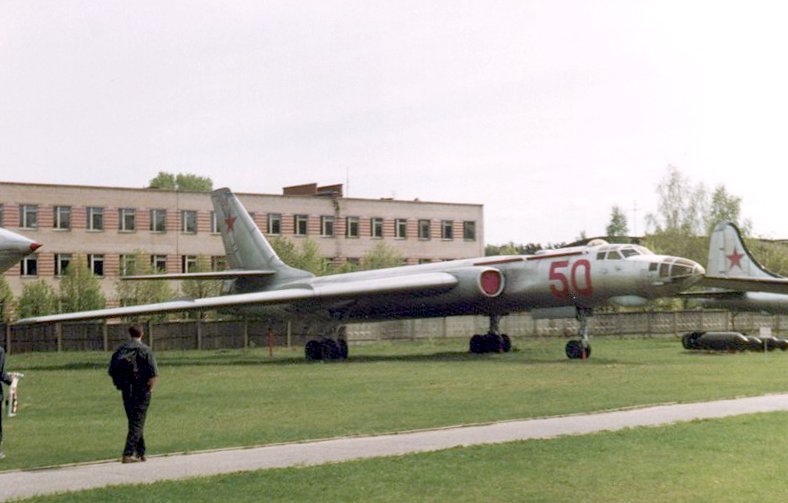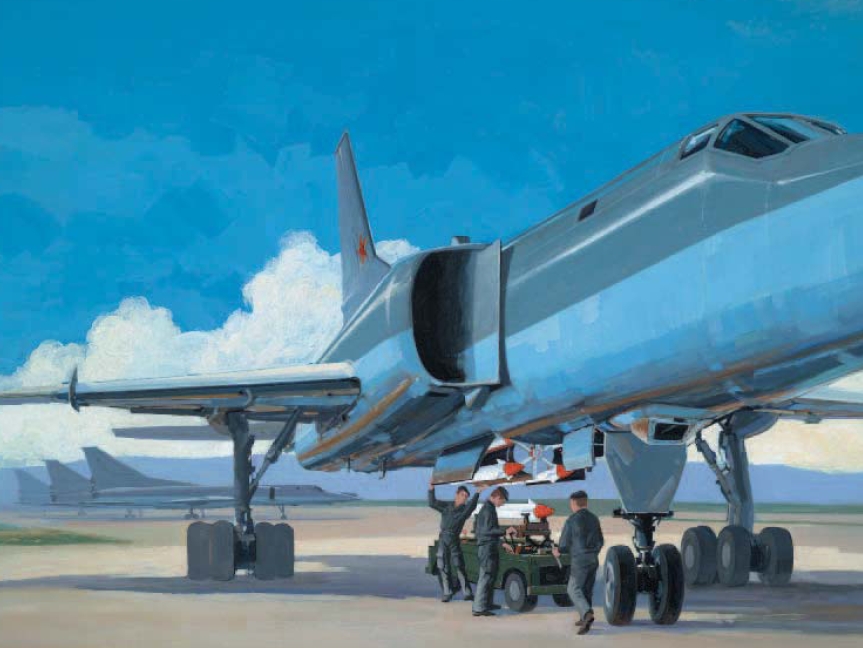|
Kaliningrad Chkalovsk
Kaliningrad Chkalovsk (also Chkalovskoye, Tchalov, or Prowehren) is a naval air base in Chkalovsk, Kaliningrad Oblast, Russia located 9 kilometers northwest of Kaliningrad. Most instances in Russian aviation literature of Chkalovsk or Chkalovskoye refer specifically to this large airfield. A significant Baltic naval base, it is Kaliningrad's largest airfield with four separate complexes for bomber and fighter parking. The base is home to the 689th Guards Fighter Regiment which uses the Sukhoi Su-27P/UP (ASCC: Flanker) as part of the 132nd Composite Aviation Division as part of the Baltic Fleet. History The construction of a military airbase began in 1935, the German Luftwaffe started to operate the ″Fliegerhorst Prowehren″ in 1936. In 1943 a concrete runway was built. Following World War II the area was annexed by the Soviet Union and the airbase was taken over by the Red Army. Chkalovsk began receiving Tupolev Tu-22 (Blinder) aircraft around 1963 and by 1967 had 30 aircra ... [...More Info...] [...Related Items...] OR: [Wikipedia] [Google] [Baidu] |
Chkalovsk Microdistrict
Chkalovsk (russian: Чкаловск) is a residential area in Tsentralny District of Kaliningrad, Russia. It was formerly known by its German name Tannenwalde as first a suburban estate and then a quarter of northwestern Königsberg, Germany. History Tannenwalde was first documented in 1807. The fort V König Friedrich Wilhelm III., named in 1894, was built near Tannenwalde as part of the new Königsberg fortifications constructed from 1872 to 1894. The estate of Tannenwalde, which contained a brickyard, developed into a garden town suburb of Königsberg in the 1920s. Its parish chapel became independent in 1930.Gause III, p. 57 Nazi Germany's air force, the Luftwaffe, constructed an air base nearby in 1935. Tannenwalde was incorporated into Königsberg in 1939. The quarter of Charlottenburg lay to the southeast. Königsberg was transferred to Soviet control in 1945 after World War II. In 1948 Tannenwalde was renamed ''Chkalovsk'', after the pilot Valery Chkalov. It contains Ka ... [...More Info...] [...Related Items...] OR: [Wikipedia] [Google] [Baidu] |
Tupolev Tu-16
The Tupolev Tu-16 ( NATO reporting name: Badger) is a twin-engined jet strategic heavy bomber used by the Soviet Union. It has been flown for almost 70 years, and the Chinese license-built Xian H-6 remains in service with the People's Liberation Army Air Force. Development In the late 1940s, the Soviet Union was strongly committed to matching the United States in strategic bombing capability. The Soviets' only long-range bomber at the time was Tupolev's Tu-4 'Bull', a reverse-engineered copy of the American B-29 Superfortress. The development of the notably powerful Mikulin AM-3 turbojet led to the possibility of a large, jet-powered bomber. The Tupolev design bureau began work on the Tu-88 ("Aircraft N") prototypes in 1950. The Tu-88 first flew on 27 April 1952. After winning a competition against the Ilyushin Il-46, it was approved for production in December 1952. The first production bombers entered service with Frontal Aviation in 1954, receiving the service designation ... [...More Info...] [...Related Items...] OR: [Wikipedia] [Google] [Baidu] |
Soviet Naval Aviation Bases
The Soviet Union,. officially the Union of Soviet Socialist Republics. (USSR),. was a transcontinental country that spanned much of Eurasia from 1922 to 1991. A flagship communist state, it was nominally a federal union of fifteen national republics; in practice, both its government and its economy were highly centralized until its final years. It was a one-party state governed by the Communist Party of the Soviet Union, with the city of Moscow serving as its capital as well as that of its largest and most populous republic: the Russian SFSR. Other major cities included Leningrad (Russian SFSR), Kiev (Ukrainian SSR), Minsk (Byelorussian SSR), Tashkent (Uzbek SSR), Alma-Ata (Kazakh SSR), and Novosibirsk (Russian SFSR). It was the largest country in the world, covering over and spanning eleven time zones. The country's roots lay in the October Revolution of 1917, when the Bolsheviks, under the leadership of Vladimir Lenin, overthrew the Russian Provisional Government that ... [...More Info...] [...Related Items...] OR: [Wikipedia] [Google] [Baidu] |
The Associated Press
The Associated Press (AP) is an American non-profit news agency headquartered in New York City. Founded in 1846, it operates as a cooperative, unincorporated association. It produces news reports that are distributed to its members, U.S. newspapers and broadcasters. The AP has earned 56 Pulitzer Prizes, including 34 for photography, since the award was established in 1917. It is also known for publishing the widely used ''AP Stylebook''. By 2016, news collected by the AP was published and republished by more than 1,300 newspapers and broadcasters, English, Spanish, and Arabic. The AP operates 248 news bureaus in 99 countries. It also operates the AP Radio Network, which provides newscasts twice hourly for broadcast and satellite radio and television stations. Many newspapers and broadcasters outside the United States are AP subscribers, paying a fee to use AP material without being contributing members of the cooperative. As part of their cooperative agreement with the AP, most ... [...More Info...] [...Related Items...] OR: [Wikipedia] [Google] [Baidu] |
Kh-47M2 Kinzhal
The Kh-47M2 Kinzhal (in Russian: Х-47М2 Кинжал, "Dagger", NATO reporting name Killjoy) is a Russian nuclear-capable hypersonic aero-ballistic air-to-surface missile. It has a claimed range of more than , Mach 12 speed (2.5 mi/s), and an ability to perform evasive maneuvers at every stage of its flight. It can carry both conventional and nuclear warheads and can be launched from Tu-22M3 bombers or MiG-31K interceptors. It has been deployed at airbases in Russia's Southern Military District and Western Military District. The Kinzhal entered service in December 2017 and was one of the six new Russian strategic weapons unveiled by Russian President Vladimir Putin on 1 March 2018. Design The missile is designed to hit NATO warships posing a threat to strategic missile systems in European Russia and to destroy NATO missile defence systems, ballistic missile defense ships and land objects close to the Russian borders. It is allegedly designed to overcome any known or planned ... [...More Info...] [...Related Items...] OR: [Wikipedia] [Google] [Baidu] |
MiG-31
The Mikoyan MiG-31 (russian: link=no, Микоян МиГ-31; NATO reporting name: Foxhound) is a supersonic interceptor aircraft that was developed for use by the Soviet Air Forces. The aircraft was designed by the Mikoyan design bureau as a replacement for the earlier MiG-25 "Foxbat"; the MiG-31 is based on and shares design elements with the MiG-25. The MiG-31 is among the fastest combat jets in the world. It continues to be operated by the Russian Air Force and the Kazakh Air Force following the end of the Cold War and the collapse of the Soviet Union in 1991. The Russian Defence Ministry expects the MiG-31 to remain in service until 2030 or beyond; that was confirmed in 2020 when an announcement was made to extend the service lifetime from 2,500 to 3,500 hours on the existing airframes. Development Origins The single-seat MiG-25 could achieve high speed, altitude and rate of climb; however, it lacked maneuverability at interception speeds and was difficult to fly a ... [...More Info...] [...Related Items...] OR: [Wikipedia] [Google] [Baidu] |
Nivenskoye
Nivenskoye (also Severnyi, Uzhnyi & Yezau (US)) ( rus, Южный) is a former interceptor aircraft air base in Kaliningrad Oblast, Russia located 17 km south of Kaliningrad. A large mile-wide taxiway ring on west side fed a series of aircraft revetments. There were remote bomber or alert revetments for about 5 aircraft. It is abandoned and in a state of decay as of 2000. Nivenskoye was a Second World War airfield, which was blown up by the Germans in 1945 during their retreat.Yezau Airfield, 6 August 1952, CIA CREST: CIA-RDP82-00457R013100280005-5, Central Intelligence Agency, Washington, DC. It was rebuilt by the Soviet Union between 1948 and 1950 using Soviet soldiers and German civilians. By 1951 it had a length of 1500 m (4920 ft) and was used by the Soviet Air Force. By 1957 up to 25 MiG-15 (Fagot) aircraft were based at the airfield. From October 1952 Nivenskoye was home to 689th Guards Fighter Aviation Regiment (689 Gv IAP, see :ru:689-й гвардей ... [...More Info...] [...Related Items...] OR: [Wikipedia] [Google] [Baidu] |
15th Independent Long-Range Reconnaissance Aviation Regiment
15 (fifteen) is the natural number following 14 and preceding 16. Mathematics 15 is: * A composite number, and the sixth semiprime; its proper divisors being , and . * A deficient number, a smooth number, a lucky number, a pernicious number, a bell number (i.e., the number of partitions for a set of size 4), a pentatope number, and a repdigit in binary (1111) and quaternary (33). In hexadecimal, and higher bases, it is represented as F. * A triangular number, a hexagonal number, and a centered tetrahedral number. * The number of partitions of 7. * The smallest number that can be factorized using Shor's quantum algorithm. * The magic constant of the unique order-3 normal magic square. * The number of supersingular primes. Furthermore, * 15 is one of two numbers within the ''teen'' numerical range (13-19) not to use a single-digit number in the prefix of its name (the first syllable preceding the ''teen'' suffix); instead, it uses the adjective form of five (''fif' ... [...More Info...] [...Related Items...] OR: [Wikipedia] [Google] [Baidu] |
Sukhoi Su-17
The Sukhoi Su-17 (''izdeliye'' S-32) is a variable-sweep wing fighter-bomber developed for the Soviet military. Its NATO reporting name is "Fitter". Developed from the Sukhoi Su-7, the Su-17 was the first variable-sweep wing aircraft to enter Soviet service. Two subsequent Sukhoi aircraft, the Su-20 and Su-22, have usually been regarded as variants of the Su-17. The Su-17/20/22 series has had a long career and has been operated by many other air forces of including the Russian Federation, other former Soviet republics, the former Warsaw Pact, countries in the Arab world, Angola and Peru. Development Shortly after the Su-7 fighter-bomber was put into service, the Sukhoi Design Bureau was ordered to develop a deep modernization program for the aircraft in the early 1960s. The program would be aimed primarily at updating on-board avionics and the takeoff/landing performance characteristics. The concept of variable-geometry wings - something gaining wider attention at that tim ... [...More Info...] [...Related Items...] OR: [Wikipedia] [Google] [Baidu] |
Tu-22M
The Tupolev Tu-22M (russian: Туполев Ту-22М; NATO reporting name: Backfire) is a supersonic, variable-sweep wing, long-range strategic and maritime strike bomber developed by the Tupolev Design Bureau in the 1960s. According to some sources, the bomber was believed to be designated Tu-26 at one time. During the Cold War, the Tu-22M was operated by the Soviet Air Forces (VVS) in a missile carrier strategic bombing role, and by the Soviet Naval Aviation (''Aviatsiya Voyenno-Morskogo Flota'', AVMF) in a long-range maritime anti-shipping role. As of 2021, before the 2022 Russian invasion of Ukraine, there were 66 of the aircraft in service. Development In 1962, after the introduction of the Tupolev Tu-22, it became increasingly clear that the aircraft was inadequate in its role as a bomber. In addition to widespread unserviceability and maintenance problems, the Tu-22's handling characteristics proved to be dangerous. Its landing speed was greater than previous bombe ... [...More Info...] [...Related Items...] OR: [Wikipedia] [Google] [Baidu] |





